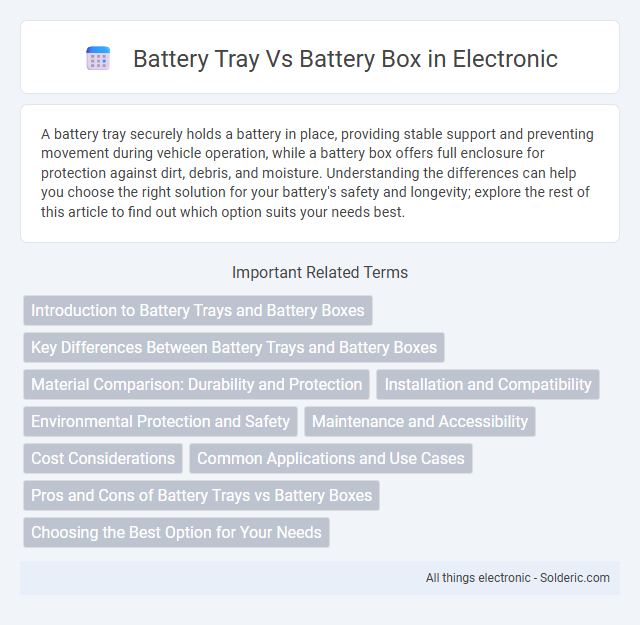A battery tray securely holds a battery in place, providing stable support and preventing movement during vehicle operation, while a battery box offers full enclosure for protection against dirt, debris, and moisture. Understanding the differences can help you choose the right solution for your battery's safety and longevity; explore the rest of this article to find out which option suits your needs best.
Comparison Table
| Feature | Battery Tray | Battery Box |
|---|---|---|
| Purpose | Secures battery in place within vehicle or equipment | Encloses battery for protection and containment |
| Protection | Basic support; limited protection from external elements | Full enclosure; protects against spills, corrosion, and impacts |
| Material | Typically metal or plastic | Usually plastic or heavy-duty polymer |
| Use Case | Used where minimal protection is sufficient | Essential for marine, industrial, or harsh environments |
| Maintenance | Easy access for battery removal and inspection | May require additional steps to access battery |
| Cost | Generally lower cost | Higher cost due to added protection features |
Introduction to Battery Trays and Battery Boxes
Battery trays provide a secure platform designed to hold and support automotive or marine batteries, ensuring stability and preventing movement during operation. Battery boxes offer enhanced protection by enclosing the battery within a durable, often weather-resistant container that shields against spills, corrosion, and external damage. Choosing between a battery tray and a battery box depends on your need for safety, environmental protection, and ease of battery maintenance.
Key Differences Between Battery Trays and Battery Boxes
Battery trays are designed to securely hold your battery in place within a vehicle or device, providing a stable base with minimal protection against environmental elements. Battery boxes, on the other hand, offer a fully enclosed solution that protects the battery from dirt, moisture, and impacts, enhancing safety and longevity. Choosing between a battery tray and battery box depends on your need for protection versus ease of access and installation.
Material Comparison: Durability and Protection
Battery trays are often made from metal or heavy-duty plastic, offering strong durability and resistance to impact, while battery boxes typically use high-density polyethylene (HDPE) or polypropylene, providing superior chemical resistance and protection against environmental elements. Metal battery trays excel in heat dissipation and structural support but may be prone to corrosion without proper coatings, whereas battery boxes offer full enclosure to guard against spills, dirt, and moisture, enhancing overall battery longevity. Your choice should consider the balance between structural strength and environmental protection based on the specific conditions of use.
Installation and Compatibility
Battery trays offer a basic mounting solution that is typically easier to install due to their lightweight design and compatibility with standard battery sizes, making them ideal for straightforward applications. In contrast, battery boxes provide enhanced protection with secure enclosures that require more precise installation to ensure proper fit and ventilation, especially for larger or specialized batteries. Choosing between a battery tray and box depends on Your vehicle's battery specifications and the level of protection needed during installation.
Environmental Protection and Safety
A battery box offers superior environmental protection by securely containing leaks, spills, and corrosive battery acid, preventing potential soil and water contamination. Battery trays provide basic support but lack the sealed enclosure needed to fully contain hazardous materials, increasing the risk of environmental exposure and safety hazards. For enhanced safety, battery boxes reduce the risk of accidental short circuits and physical damage, ensuring safer handling and storage in various industrial and automotive applications.
Maintenance and Accessibility
Battery trays offer easier maintenance and accessibility by securely holding the battery while allowing quick visual inspection and replacement. Battery boxes provide enhanced protection against environmental factors and spills but may require more effort to access and clean. Your choice should balance convenience for regular maintenance with the level of protection needed for your battery's operating conditions.
Cost Considerations
Battery trays generally offer a lower-cost solution compared to battery boxes, as they are simpler in design and primarily provide support without extensive protective features. Battery boxes, while more expensive, add value through enhanced durability, corrosion resistance, and containment of acid spills, reducing potential maintenance and replacement costs. Cost considerations should balance initial investment against long-term protection and safety benefits provided by battery boxes.
Common Applications and Use Cases
Battery trays are commonly used in automotive and marine applications for securely mounting batteries while allowing easy access for maintenance, making them ideal for vehicles and boats with limited space. Battery boxes provide enhanced protection against environmental factors like moisture, dirt, and acid leaks, often seen in off-road vehicles, RVs, and industrial equipment where battery safety and durability are critical. Choosing between a battery tray and a battery box depends on your specific needs for protection and accessibility in environments ranging from everyday passenger cars to heavy-duty machinery.
Pros and Cons of Battery Trays vs Battery Boxes
Battery trays offer a lightweight, cost-effective solution for securing batteries, providing easy access and ventilation, but they lack full protection against environmental elements and impacts. Battery boxes enclose the battery completely, offering superior protection from dirt, moisture, and accidental damage, enhancing safety and extending battery life, though they can add weight and limit airflow. Your choice depends on whether you prioritize accessibility and ventilation (battery trays) or maximum protection and durability (battery boxes).
Choosing the Best Option for Your Needs
Battery trays offer a simple, cost-effective solution for securing batteries in place, ideal for standard automotive or marine applications where minimal protection is required. Battery boxes provide enhanced safety by enclosing the battery, protecting against acid spills, corrosion, and physical damage, making them suitable for hazardous environments or off-road vehicles. Selecting the best option depends on factors such as exposure to elements, required durability, and personal safety preferences.
Battery tray vs battery box Infographic

 solderic.com
solderic.com